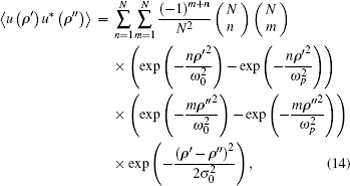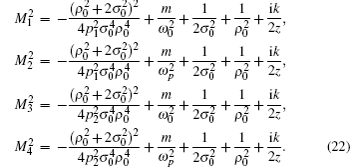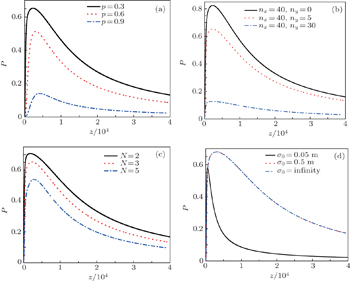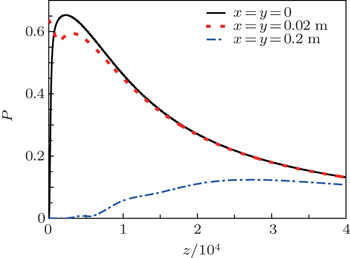† Corresponding author. E-mail:
Project supported by the Major Research Plan of the National Natural Science Foundation of China (Grant No. 61405205).
Non-classical polarization properties of dark hollow beams propagating through non-Kolmogorov turbulence are studied. The analytic equation for the polarization degree of the quantization partially coherent dark hollow beams is obtained. It is found that the polarization fluctuations of the quantization partially coherent dark hollow beams are dependent on the turbulence factors and beam parameters with the detection photon numbers. Furthermore, an investigation of the changes in the on-axis propagation point and off-axis propagation point shows that the polarization degree of the quantization partially coherent dark hollow beams presents oscillation for a short propagation distance and gradually returns to zero for a sufficiently long distance.
Polarization is a key ingredient of a light beam which has a number of practical applications both in the quantum and classical realms.[1–10] In recent years, growing attention has been focused on the polarization fluctuations of quantum light propagating through a turbulent atmosphere since it plays an important role in free-space optical communications and remote sensing.[11–13] The polarization properties of a linearly polarized quantum beam in turbulent atmosphere have been reported.[14–17] But, few schemes studied the quantum polarization fluctuations of two-orthogonally-polarized-mode field propagation through the turbulent atmosphere.
Dark hollow beams (DHBs) are the beams with zero on-axis intensity which have important applications in laser optics, atomic optics, binary optics, optical trapping of particles and medical sciences.[18] DHBs can be generated by using various methods, such as geometrical optical method, mode conversion, optical holography, transverse-mode selection, hollow-fiber method, etc.[19–24] DHBs have many advantages over a Gaussian beam and flat-topped beam for overcoming the destructive effect of atmospheric turbulence from the aspect of scintillation,[25,26] hence, have important potential applications in free-space optical communications. Up to now, the propagation properties of the partially coherent DHB in turbulent atmosphere have been studied and the polarization degree of partially coherent DHB has also been reported.[27–29] However, the quantum polarization fluctuation of quantization partially coherent DHB has not been formulated yet. According to the two unsettled issues stated above, in this paper, by using quantum Stokes operators and non-Kolmogorov spectrum model of index-of-refraction fluctuation, we develop a theoretical model for the quantum polarization fluctuations of the two-orthogonally-polarized-mode quantization partially coherent DHB propagating in a turbulent atmosphere.
The rest of this paper is organized as follows. In Section 2 we summarize the necessary basic principles of the quantum Stokes operators and the polarization degree of the two-orthogonally-polarized-mode field. In Section 3 the quantum Stokes operators in a turbulent atmosphere are studied and the degree of polarization of quantization partially coherent DHB in a turbulent atmosphere is obtained. Numerical results and discussions are given in Section 4. Conclusions are presented in Section 5.
The polarization state of the two-orthogonally-polarized-mode field can be characterized by the Stokes operators:[30]



We assume that two-orthogonally-polarized-mode field is initially in the Fock state, i.e.

The degree of polarization for two orthogonally polarized modes of light when it propagates through a turbulent atmosphere can take the form


For two orthogonally polarized modes of light, where âx ≠ 0 and ây ≠ 0, one can obtain




The propagating quantum field in the turbulent atmosphere can be expressed as









The ensemble average photon number of j polarization mode of quantum field when it propagates through a turbulent atmosphere can be obtained as






After tedious integral calculations, the photon number of quantization partially coherent DHB for two orthogonally polarized modes in atmospheric turbulence is obtained as








Based on the derived analytical results in the above section, we study the numerical results of the influence of turbulence on the polarization degree of quantization partially coherent DHB. The non-Kolmogorov spectrum parameters are set to be L0 = 1 m, l0 = 0.001 m, 
Figures
Figures
Figure
In this work, we propose a theoretical model to describe the polarization degree of the two-orthogonally-polarized-mode quantization DHB propagating through non-Kolmogorov turbulence. The analytical expression for the polarization degree of the two-orthogonally-polarized-mode quantization partially coherent DHB is obtained. The polarization degree of the two-orthogonally-polarized mode quantization partially coherent DHB is investigated for the turbulence factors and beam parameters with the detection photon numbers. An investigation of the changes in the on-axis propagation point and off-axis propagation points shows that the polarization degree of quantization partially coherent DHB presents oscillation for a short propagation distance and gradually returns to zero for a sufficiently long distance. That is to say, the quantum optics will turn into the classical optics as the beam propagates. Furthermore, the quantum polarization fluctuation is slight for great difference in detection photon number between two orthogonally polarized modes: the higher the spectrum power-law exponent, the larger the inner scale of turbulence and coherent length, or the smaller the refractive index structure constants, outer scale of turbulence, central dark sizes p and beam order N are. Therefore, we should choose very different detection photon numbers in two orthogonally polarized modes, smaller central dark size p, smaller beam order N and weak turbulence, when the robustness of polarization is taken as the carrier in quantum information processing. The result can be employed in applications, such as free-space optical communications and remote sensing.
| 1 | |
| 2 | |
| 3 | |
| 4 | |
| 5 | |
| 6 | |
| 7 | |
| 8 | |
| 9 | |
| 10 | |
| 11 | |
| 12 | |
| 13 | |
| 14 | |
| 15 | |
| 16 | |
| 17 | |
| 18 | |
| 19 | |
| 20 | |
| 21 | |
| 22 | |
| 23 | |
| 24 | |
| 25 | |
| 26 | |
| 27 | |
| 28 | |
| 29 | |
| 30 | |
| 31 |





